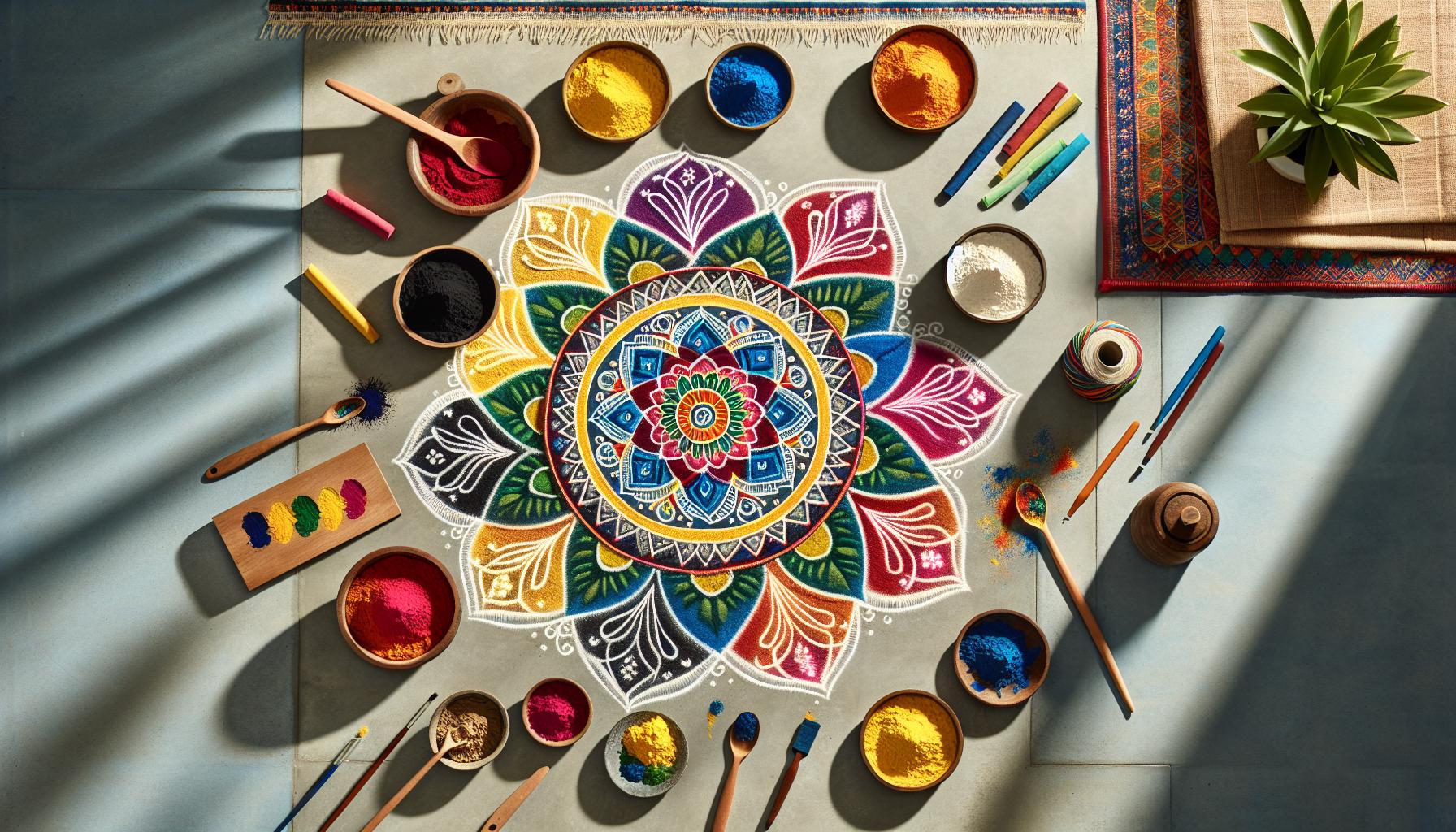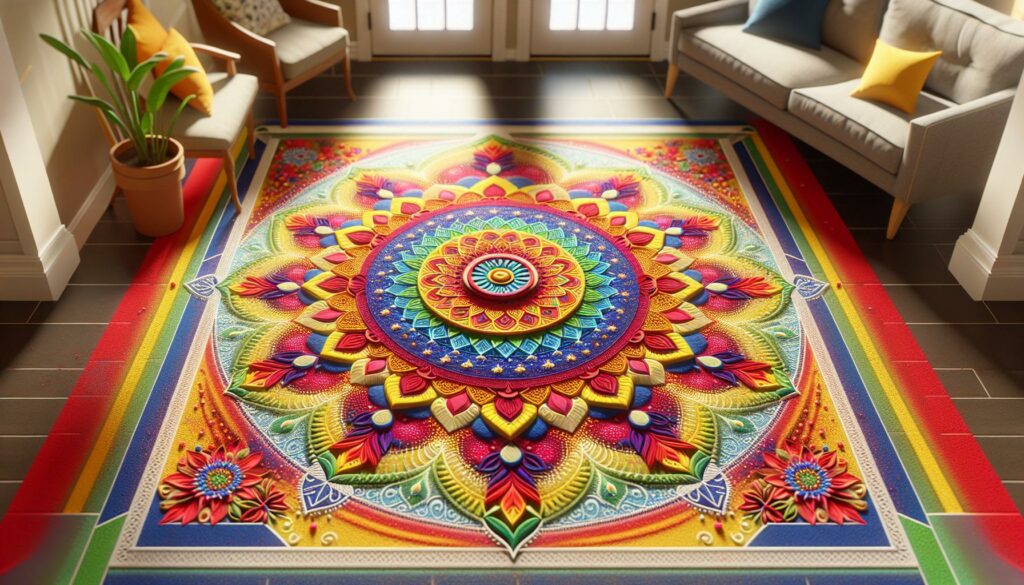Rangoli is more than just a decorative art form; it’s a vibrant expression of culture and tradition. I’ve always been captivated by the intricate patterns and colors that bring life to any celebration. Whether it’s Diwali, Pongal, or a simple family gathering, a beautiful rangoli design can transform an ordinary space into something extraordinary.
Key Takeaways
- Cultural Significance: Rangoli is a vibrant expression of culture, enhancing celebrations like Diwali and Pongal with its intricate designs and colors.
- Modern Twist: The easy:hb–x0w2qoe= rangoli design combines traditional elements with modern geometric patterns, making it accessible to people of all skill levels.
- Step-by-Step Creation: The design can be made easily by following structured steps: outlining with chalk, filling in colors, using stencils, layering for depth, and adding final details.
- Aesthetic Elements: A thoughtfully chosen color palette and distinct geometric shapes enhance the rangoli’s appeal and cultural significance, symbolizing unity and joy.
- Techniques for Success: Practice with simple designs, use guides for accuracy, experiment with materials, and allow time for details to improve your rangoli outcomes.
Easy:hb–x0w2qoe= Rangoli Design
The easy:hb–x0w2qoe= rangoli design offers a modern twist to traditional art without compromising on its beauty. This design incorporates geometric patterns, vibrant colors, and minimalist elements. I appreciate how it balances simplicity with elegance, making it accessible for both beginners and experienced artists.
Creating the easy:hb–x0w2qoe= rangoli design involves straightforward steps. First, using colored powders or chalks enhances the vibrant hues in the design. Second, selecting a flat surface allows for the best presentation of the rangoli. Third, employing a stencil can ensure precise shapes and patterns, which simplifies the process.
The easy:hb–x0w2qoe= rangoli design forms a striking centerpiece during festive occasions. It enhances celebrations such as Diwali, as it invites guests and conveys welcoming sentiments. Additionally, this design can adapt to various spaces, from homes to event venues, making it versatile.
Using the easy:hb–x0w2qoe= rangoli design fosters creativity and encourages participants of all ages to engage in this cultural practice. It serves as a unique way to express artistic flair while honoring tradition, representing joy and togetherness in festive settings.
Elements of the Design

The easy:hb–x0w2qoe= rangoli design incorporates specific elements that enhance its aesthetic appeal and cultural significance. These elements include a carefully chosen color palette and distinct patterns and shapes that contribute to the overall design.
Color Palette
Vibrant colors define the easy:hb–x0w2qoe= rangoli design. Bold hues such as red, yellow, blue, and green draw attention, creating an inviting atmosphere. I mix shades to achieve gradient effects, adding depth to the design. Combining bright and pastel colors allows for a playful contrast. Using eco-friendly colored powders not only enriches the appearance but also respects the environment. This thoughtful color selection enhances the festive spirit, making the rangoli more engaging.
Patterns and Shapes
Geometric shapes dominate the easy:hb–x0w2qoe= rangoli design, allowing for easy replication by artists of all skill levels. Circular patterns represent unity and wholeness, while triangular shapes convey strength and stability. I often implement symmetrical designs to create balance, enhancing visual harmony. Incorporating floral motifs adds a touch of nature, deepening the connection to cultural traditions. These diverse patterns and shapes contribute to a dynamic yet cohesive design, making it a striking focal point during celebrations.
Step-by-Step Guide

Creating the easy:hb–x0w2qoe= rangoli design involves specific materials and techniques. Follow these steps to bring this vibrant art form to life.
Materials Needed
- Colored Powders: Use eco-friendly powders in red, yellow, blue, green, and white for a striking palette.
- Chalk or Soft Pastels: Choose these for outlining designs on surfaces.
- Stencil or Template: Utilize pre-made stencils for precise geometric shapes.
- Flat Surface: Select a clean area like a floor, patio, or entryway for your design.
- Optional Tools: Gather a spoon or funnel for pouring powders and brushes for detailing.
- Outline First: Draw the basic shape using chalk or soft pastels to ensure proportions align.
- Fill with Color: Carefully fill in outlined areas with colored powders, maintaining a steady hand for clean edges.
- Use Stencils: Place stencils over outlined designs to achieve uniform shapes easily.
- Layer Gradients: Blend shades by layering colors, creating depth and vibrancy in your rangoli.
- Finish with Details: Add intricate patterns or flourishes to enhance the overall design.
Following these straightforward steps fosters creativity and makes the rangoli design approachable for everyone, from beginners to seasoned artists.
Tips for Perfecting Your Rangoli

Achieving a stunning rangoli design takes practice and attention to detail. I’ll share effective techniques and highlight common mistakes to help you create beautiful art.
Practice Techniques
- Start with Simple Designs: Begin with basic geometric shapes and gradually progress to intricate patterns. This builds confidence and skill.
- Use a Guide: Create outlines with chalk to establish the structure before filling in colors. This method ensures accuracy and symmetry.
- Experiment with Materials: Test different types of colored powders and stencils. Exploring various textures and finishes can enhance your design.
- Layer Colors: Apply colors in layers to achieve depth. Start with lighter shades and gradually add darker tones for a rich, dynamic effect.
- Practice Regularly: Set aside time for practice. Consistent effort significantly improves skill over time, allowing for more creativity in designs.
- Skipping the Planning Stage: Failing to outline the design can lead to uneven shapes and messy outcomes. Always map out your pattern first.
- Ignoring Space Management: Overcrowding the design can diminish its impact. Maintain balance by allowing sufficient space between elements.
- Using Non-Eco-Friendly Materials: Avoid using harmful substances that damage the environment. Choose eco-friendly options for a responsible approach.
- Neglecting Safety Precautions: When using tools or materials, ensure a safe workspace. Accidents can disrupt the creative process.
- Rushing Through the Process: Crafting a rangoli requires patience. Taking time to perfect details enriches the overall presentation.
Creating the easy:hb–x0w2qoe= rangoli design has been an enriching experience for me. It beautifully combines tradition with a modern flair that resonates with anyone who appreciates art. The vibrant colors and geometric shapes not only enhance festive occasions but also invite creativity from all ages.
I love how this design encourages everyone to participate and express their artistic side. Whether you’re a beginner or an experienced artist you can find joy in crafting this rangoli. It’s more than just a decoration; it’s a celebration of culture and togetherness. So grab your materials and start creating your own masterpiece. You’ll be amazed at the transformation it brings to your space and the happiness it spreads during celebrations.
